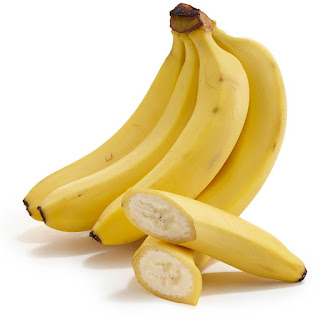BANANA
A banana is an edible fruit – botanically a berry produced by several kinds of large herbaceous flowering plants in the genus Musa. In some countries, bananas used for cooking may be called "plantains", distinguishing them from dessert bananas. The fruit is variable in size, color, and firmness, but is usually elongated and curved, with soft flesh rich in starch covered with a rind, which may be green, yellow, red, purple, or brown when ripe. The fruits grow in clusters hanging from the top of the plant. Almost all modern edible seedless (parthenocarp) bananas come from two wild species Musa acuminata and Musa balbisiana. The scientific names of most cultivated bananas are Musa acuminata, Musa balbisiana, and Musa paradisiaca for the hybrid Musa acuminata. balbisiana, depending on their genomic constitution. The old scientific name Musa sapientum is no longer used.
Musa species are native to tropical Indomalaya and Australia, and are likely to have been first domesticated in Papua New Guinea. They are grown in 135 countries, primarily for their fruit, and to a lesser extent to make fiber, banana wine, and banana beer and as ornamental plants. The world's largest producers of bananas in 2016 were India and China, which together accounted for 28% of total production.
TOFFEE
Toffee is a confection made by caramelizing sugar or molasses (creating inverted sugar) along with butter, and occasionally flour. The mixture is heated until its temperature reaches the hard crack stage of 149 to 154 °C (300 to 310 °F). While being prepared, toffee is sometimes mixed with nuts or raisins.
The process of making toffee requires the boiling of ingredients until the mix is stiff enough to be pulled into a shape which holds and has a glossy surface. The resulting mixture will typically be poured into a shallow tray and allowed to cool to form a slab. Different mixes, processes, and most importantly, temperatures, will result in different textures and hardnesses, from soft and often sticky to a hard, brittle material. A brown color, and smoky taste, is imparted to the toffee by the caramelization of the sugars.
APRICOT
An apricot is a fruit, or the tree that bears the fruit, of several species in the genus Prunus (stone fruits). Usually, an apricot tree is from the species P. armeniaca, but the species P. brigantina, P. mandshurica, P. mume, and P. sibirica are closely related, have similar fruit, and are also called apricots.
Dried apricots are a type of traditional dried fruit. The world's largest producer of dried apricots is Turkey. When treated with sulfur dioxide (E220), the color is vivid orange. Organic fruit not treated with sulfur dioxide is darker in color and has a coarser texture. When apricots are dried, the relative concentration of nutrients is increased, with vitamin A, vitamin E, potassium and iron having Daily Values above 25% (table).



Komentar
Posting Komentar